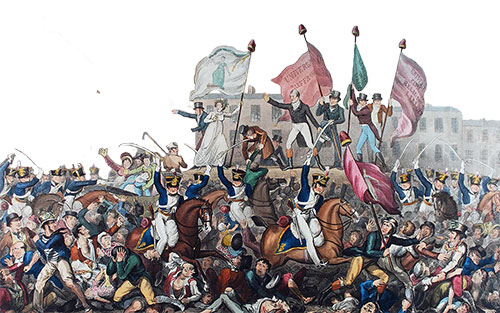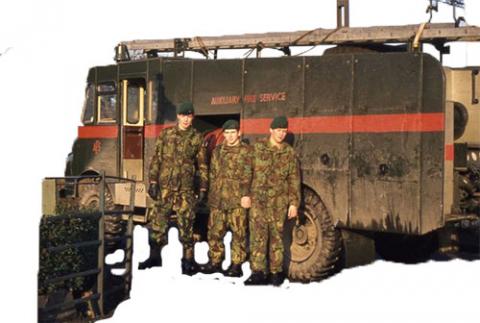
The UK is in the midst of industrial action on a scale not seen since the 1970s. With key public sector workers walking out over below-inflation pay offers, the government have asked the military to plug the gap. Drafting in the armed forces may keep some basic services running but it is also designed to weaken the power of unions. With the government threatening new anti-strike legislation, we should remember how military confrontation with strikers was the weapon of choice until the Second World War.
The armed forces are clearly not equipped to do many of the specialised jobs performed by strikers. Army personnel running ambulance services have not been allowed to use blue lights or administer medical care.
Despite being accused by politicians of deliberately harming patients, paramedics have committed to remaining on hand to save lives during the strike.
Press reports also suggest that military personnel, with only five days of quick-fire training, were unable to provide full passport control.
Soldiers ensuring the continued movement of people and goods at airports and ports also glosses over the wider violence at work in an immigration policy that embedded the armed forces in border control in the English Channel during 2022.
‘Alarming’
The use of the military in civilian arenas and disputes is proving controversial, even within the mainstream.
Senior journalist Jack Kessler told readers of the London Evening Standard that ‘our growing reliance on the army to do all sorts of things... is somewhat alarming’.
Mirror columnist Brian Reade sarcastically suggested the next army recruitment advert will invite potential soldiers to ‘be part of a cack-handed attempt to deny fellow public servants a living wage by becoming a scab and starving them back into work’.
One former head of the British army, lord Richard Dannatt, was critical from an operational perspective, telling the Daily Mail that strike-breaking risked damaging soldiers’ morale as well as recruitment and retention.
Despite the impracticality of bringing in soldiers to run the ticket barriers at railway stations such as Euston or Lime Street, let alone to operate trains, the calls emerge each time, especially from right-wing voices that often hark back to similar periods in the past.
The British military has stepped in during periods of militant workers’ activity since the Industrial Revolution (and to brutally suppress indentured workers before that). Domestically, they have intervened in one of two ways: to break strikes with force, actual or implied; and to take over jobs that workers have withdrawn their labour from.
Who strikes first
At one time, the British armed forces had a policing role within Great Britain, a role that was more recently evident in Northern Ireland.
The military was routinely used to suppress movements like the Luddites, but its most famous outing was probably during the Peterloo Massacre. In 1819, the local yeomanry rode with sabres swinging into a mass protest against high unemployment and high prices at St Peter’s Field in Manchester. The violence left hundreds injured and 15 dead.
In 1911, two men were shot by soldiers in Liverpool during riots arising from a major transport workers dispute. A warship was docked in the Mersey and 50,000 troops were mobilised nationally at the time, although rail strikes made moving them across the country difficult.
A year before, troops were deployed by Winston Churchill to support police during riots and strikes in the mining town of Tonypandy, South Wales. One civilian death and hundreds of injuries resulted from the clashes.
The largest industrial action in British history was the 1926 general strike, which centred on miners’ hours and pay but which pulled in virtually the entire working class. Anti-strike volunteers and the army were deployed to run and protect key transport routes, printing presses and factories.
After nine days, the action ended in defeat for the strikers.
In 1975, as the role of the military to quell dissent evolved, soldiers were called in to clear refuse during the binmen’s strike in Glasgow. They were paid an extra 50p a week until the strike ended. Two years later, Green Goddess fire trucks were used by soldiers as they undermined striking firefighters – and they were rolled out for the same reason in 2002.
The military’s role in strike-breaking has shifted towards maintaining services. This has enabled it to distance itself from policing and attacking strikers while still being hugely damaging to workers’ power.
In an age where the military is hyper-sensitive to media representation and the need to maintain a favourable recruitment climate, it is good to look like you are keeping the country running.

A Stirling job
There was another kind of militarist effort to sabotage striking workers brewing in the mid-1970s. It came from the influential veteran officer colonel David Stirling, the revered founder of the SAS.
In August 1974, Peace News published secret documents revealing that Stirling was attempting to build an organisation that he hoped would ‘curb the power of the militant Trade Unionists’. It was to be funded in part by arms dealers.
Stirling created the organisation – ‘Great Britain 75’ – because he was critical of the British army’s lack of contingency planning. He believed that troops would be required to back up the police in the event of civil unrest, and so wouldn’t be available to run vital services and infrastructure.
Although acting outside of the military, Great Britain 75 would take inspiration from the role the armed forces played during the 1926 General Strike, but with the understanding that some jobs now required skills the average soldier did not possess.
However, Stirling was still keen to recruit from the ranks and stated that, while they could not approach the Territorial Army directly, they could certainly recruit individuals with experience of it.
Like the cross-paper condemnation of 2022, The Times and the Guardian were critical of the plans, with the former stating that ‘their fault is to purport to offer civil precautions of a kind which it is for the government, and it alone, to provide’.
Eroding solidarity
As a policing force normally deployed overseas, the military remains ready-made for breaking strikes domestically.
Service personnel have reduced labour rights and are not allowed to unionise. Although the ranks are overwhelmingly drawn from the working classes, potential solidarity is eroded by a military culture which is predominantly conservative and hierarchical.
Any fear that rank-and-file military personnel may side with their own is also offset by deep conditioning in training which encourages a contemptuous attitude towards civilians.
The prospect of a unionised military is remote, although from time to time it reappears on the political scene. Labour’s 2019 manifesto pledged to consult on establishing an armed forces federation – in effect a union without the right to strike – and the idea was raised again during the Armed Forces Bill passed through parliament in 2021.
However, such a federation would have limited power, as with the Police Federation, which was founded to avoid a repeat of the 1918 and 1919 police strikes.
The lack of representation within the ranks is evident in the poor state of service personnel accommodation and a recent pay award that is well below inflation. It also results in personnel being forced to take part in breaking strikes and keeping wages down elsewhere, contributing to the undermining of the trade union movement through divide and rule.

